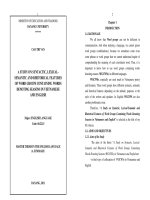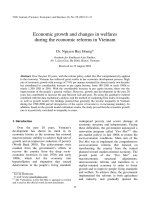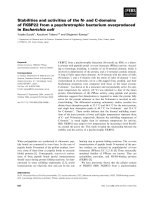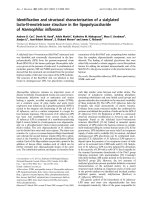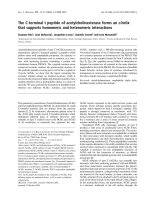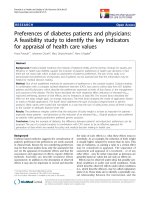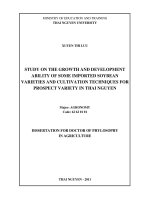STUDY AND EXPLORE THE POTENTIAL AND DEVELOPMENT DIRECTION OF TOURISM AS AN IMPORTANT ECONOMIC SECTOR IN VIETNAM
Bạn đang xem bản rút gọn của tài liệu. Xem và tải ngay bản đầy đủ của tài liệu tại đây (613.75 KB, 52 trang )
STUDY AND EXPLORE THE POTENTIAL AND DEVELOPMENT
DIRECTION OF TOURISM AS AN IMPORTANT ECONOMIC SECTOR IN
VIETNAM
ABSTRACT
Vietnam's tourism industry is considered an important economic sector because of its
geographical location with rich and diverse tourism potential. The study was
conducted to find solutions to improve the ability to exploit the potential of Vietnam's
tourism industry to become a spearhead economic sector in the near future. The study
used both research methods including qualitative research method and quantitative
research method. By qualitative research method, the study has provided an overview
of Vietnam's tourism industry including growth rate, the contribution of tourism to the
national economy. The research method is carried out through surveying 200
individuals currently working in the tourism industry in Vietnam about the factors
affecting the ability to exploit the potential of tourism development in Vietnam. The
results of the regression analysis have shown that all four factors in the research model
have a positive impact on Vietnam's ability to develop tourism in the following
order:1) Destination's Supply and Consumption Capacity; (2) Place's Demand and
Purchasing Power; (3) The Development Value of Destination Resource; (4)
Destination's Tourism Industry Contribution.On the basis of the research results, some
specific recommendations are proposed to improve the ability to exploit the potential
of tourism to become a spearhead economic sector of Vietnam, which are presented in
detail below.
CHAPTER 1: INTRODUCTION
1.1 Rational for topic
Tourism is one of the main pillars of international trade, plays an important role in the
economies of many countries in the world, and is an important source of income for
many developing countries (Costa, 2017; Mason, 2015), especially for countries with
tourism development potential. According to Turner and Freiermuth (2016), in the
context of the modern economy, tourism has become one of the key economic sectors
for sustainable development in developed and emerging economies, as it provides a
wide range of cultural, social, technological, experiential and natural products for
recreational and commercial activities. The World Travel and Tourism Council
(WTTC 2021) also pointed out that tourism plays an important role in creating
employment opportunities, including direct, indirect and influence. Reason; It is
estimated that a quarter of the global employment opportunities are created,
accounting for about 334 million, accounting for 10.6% of the total employment
opportunities, accounting for 9.2 trillion US dollars and accounting for 10.4% of
global GDP. At the same time, international tourists' consumption accounts for 6.8%
of total exports and 27.4% of total global service exports, contributing 1.7 trillion US
dollars in 2019. Therefore, tourism is considered as an important part of international
trade in services, and has become a prominent and burgeoning industry. Compared
with many countries in the region, Vietnam is one of the countries with great potential
for tourism development, especially marine tourism and ecotourism.
Vietnam's tourism industry is considered an important economic sector because of its
geographical location with rich and diverse tourism potential. In 2019, Vietnam's
tourism industry welcomed 18 million international tourists for the 1time, an increase
of 16.2% over 2018. Between 2015 and 2019, the number of international tourists in
Vietnam increased 2.3 times, from 7.9 million to 18 million, with an average growth
rate of 22.7%/year. Vietnam has been one of the fastest growing tourist countries in
the world (ONS, 2019). In 2019, Vietnam Tourism Bureau won the "World Best
Heritage Destination" awarded by the World Travel Award and the "World Best Golf
Destination" awarded by the World Golf Award. In addition, the World Travel
Awards also rated Vietnam as the best destination in Asia in 2018-2019,
However, Vietnam's tourism industry has certain limitations, such as: low return rate
(10-40%); International tourists in Vietnam do not spend much because of the lack of
attractiveness and cohesion of Vietnamese tourism products, the lack of
diversification of recreational activities, shopping and customer service, and the
ineffective promotion... This may be due to resource mechanisms, operational
mechanisms, the absence of an overseas tourism promotion office, and the absence of
operational and operational tourism development and support funds; Airport
infrastructure approximates to be overloaded and cannot meet the high growth rate of
tourist numbers; Entry visa policies remain limited compared to directly competitive
destinations for Vietnamese tourism, such as Laos and Thailand. For the above
reasons,
1.2 Purpose of the study
The purpose of this study is to understand the potential and current situation of
tourism development in Vietnam. On this basis, this paper puts forward the direction
and solutions to improve the ability of Vietnam's tourism to develop into an important
economic sector in Vietnam.
In order to achieve the overall goal, the specific objectives of this theme include: (1)
inventory and evaluation of the conditions and potential of tourism development in
Vietnam; (2) Analyze the current situation of tourism in Vietnam from 2016 to 2020.
Using the theoretical and practical basis of tourism in the world and Vietnam, this
paper provides appropriate directions and solutions for the goal of developing tourism
as an important economic sector in Vietnam .
1.3 Subjects and scope of study
The subjects of this study is the natural tourism resources, cultural tourism resources
and tourism activities in Vietnam
The study was conducted within Viet Bam and collected travel data between 2016 and
2020.
1.4 Research significance
The main research result of this paper is to evaluate and analyze the potential of
tourism in Vietnam, and then put forward that tourism should be developed into an
important economic sector in Vietnam. At the same time, this thesis is the result of
interdisciplinary research, which makes use of the knowledge of many scientific
disciplines: tourism, geography, history, economics and literature... Therefore, a
comprehensive understanding of the tourism potential and current situation of cities is
obtained, not only based on economic data, but also based on the analysis of human
values and social changes, and the influence of natural changes on tourism activities.
CHAPTER 2: LITERATURE REVIEW
2.1 Concept of Tourism
Up to now, there is no common and unified definition of "tourism" (Buckley, 2012).
According to Perles & Ivars (2018), tourism involves different themes, entities and
directions, including many different economic, environmental and social activities.
The World Tourism Organization (UNWTO) defines tourism as an activity in which
individuals regularly travel outside the environment (their daily residence) for a period
of no more than one year. For one year in a row, the main purpose of their travel has
nothing to do with the money-making activities they go to (UNWTO, 2018). Tourism
plays an important role in the global economy. It creates economic benefits for local
economies and energy for small and medium-sized enterprises, thereby creating
millions of jobs. It is also boosted economic development in developing countries
(Robin, Pedroche, & Astorga, 2017; Boluk, Cavaliere, & Higgins-Desbioles, 2019;
Batle, Orfila-Sintes, & Moon, 2018). However, the negative aspect of tourism lies in
its negative impact on the environment, as it causes environmental damage, pollution,
biodiversity loss and heritage degradation (Costa, Rodrigues, & Pacheco, 2020; Girard
& Nocca 2017). The development and expansion of tourism has led to the extensive
exploitation of resources such as water and energy and to the generation of large
amounts of waste (solid waste and wastewater) that need to be properly managed. The
increase in travel also leads to more travel, resulting in road congestion, noise and air
pollution, and therefore CO2 emissions. Due to unsustainable economic and
environmental imbalances,
2.2 The role of tourism in the national economy
The first,Tourism economy contributes to increase national income through foreign
currency collection, plays a great role in balancing the balance of international
payments.
Tourism services have high export value and the highest socio-economic efficiency in
service export activities, especially in terms of foreign currency revenue and labor
attraction and job creation. Import and export of services also have a great influence
on the balance of payments of the entire economy.
SecondTourism economy contributes to attracting foreign investment capital,
participating in expanding domestic and international markets.
The current trend of economic restructuring in the world shows that the value of the
service industries increasingly accounts for a high proportion of the total social
product. Therefore, when businessmen look for the efficiency of capital, tourism is an
attractive business compared to many other economic sectors. The tourism economy
offers a high rate of return, the investment capital in tourism is relatively small
compared to the heavy industry and transportation industry, the ability to recover
capital is fast, the technology is not complicated, the level of risk is low. low risk. In
particular, through international and regional cooperation in the field of tourism,
countries can take advantage to attract foreign investment capital. Therefore, tourism
economic development is considered an important channel in attracting foreign
investment for socio-economic development of each country. The development of
tourism economy will lead to the development of other economic sectors because
tourism products are interdisciplinary and have relationships with many fields in the
economy. Stemming from this demand of tourists, the tourism industry is constantly
expanding its activities through inter-sectoral, inter-regional and transnational
relationships. Therefore, economic tourism participates in expanding domestic and
international markets for each country.
Tuesday,tourism economy contributes to enhancing the exchange and integration of
the country with the region and the world.
The interaction of factors such as: natural conditions, socio-psychology, living
environment, tourists... makes the tourism economy always have a constant
development movement. It is the thought of accepting the old, being confined in
familiar motifs, and refusing to innovate that has created the failure of the tourism
economy in some countries. Since then, the requirement for tourism economic
development is to expand links and cooperation between countries in the region and
the world. For local tourism product and service suppliers, it is necessary to expand
relationships to learn and exchange experiences to create rich, diverse, and different
products. take advantage of comparative advantage. For the residential community at
the tourist destination, through the activities of the tourism economy,
2.3 Tourism Development Potential
According to Elliot et al. (2011), the concept of tourism development potential is
understood as an assessment form to predict the sustainable development of tourism,
which makes it easier for decision makers to make decisions related to tourism
destinations (Andrades et al., 2017). Tourism potential of a region or a country has
always been a topic of great concern and research by tourism researchers. According
to Crettaz (1976), the potential of tourism was initially considered as a factor in
meeting the complex needs of tourists. However, through the development and
research process, by the 1990s, tourism potential has been widely applied in the
economic and geographical fields, and fought a material and non-material aggregate
with the ability to promote the capitalization of tourism and give full play to its
functions (Corneliu, 2010; Glavan, 1996; Mamun et al., 2012). In addition, in the later
period, the concept of tourism development potential was considered from other
perspectives such as social and environmental factors of tourist destinations
(Havlíková, 2019; Shohan et al., 2012). Then, most of the discussions about the
concept and connotation of tourism development potential are based on sustainable
development. Ma Hedong (1997) thinks that the sustainable development potential of
a region's tourism is the sum of the supply limit of regional environment, social and
economic support and tourism resources in a certain period of time. Yang (2006)
proposed that the tourism development potential of a region or country is the ability to
promote the sustainable development of tourism under the stimulation of some factors.
Wang (2008) emphasized the study of tourism development potential that tourism
development potential is the space for sustainable development of tourism under the
capacity of tourism resources, social economy and environment. This is an important
factor to measure the development of tourism in a region or a country, and it is also a
comprehensive scale to measure the sustainable development prospect of regional
tourism (Wang, 2008). Based on the multi-disciplinary perspectives of geography,
economics and management, under the background of spatial scale and sustainable
development of tourist destinations, this study holds that tourism development
potential is the exchange and transformation ability of destination resources, society,
economy and technology complex system, and is the driving force of sustainable
development.
2.4 Previous relevant studies
Yuying Chen et al. (2021) conducted a study to assess the tourism development
potential of provinces along the Silk Road in China. In this study, the authors
emphasized that the assessment of tourism development potential is one of the
important activities and plays a fundamental role in the implementation of basic
sustainable tourism development plans and policies.The purpose of this study is to
develop an effective multi-dimensional map to evaluate the tourism potential of
destination areas along the Silk Road in China by building models. Tourism potential
index. On the basis of literature review, this study develops four regular layers
(tourism supply and consumption (X1), tourist demand and purchasing power (X2),
destination resource development value (X3) and destination tourism contribution
(X4) and 31 factors representing the four regular layers. Then, all factor classes are
assigned according to the statistical data provided by the local statistics bureau within
the scope of the study in 2019. The data are analyzed by SPSS 24.0. The results show
that the factors of tourism potential have different coefficients: y=0. 2573x 1 +0. 1305
x 2 +0. 3177x3 +0. 2945 x 4.
Xueyan Li, Xiaoxiao Zhan, Jinli Jiang (2021) carried out a comprehensive evaluation
of silkworm tourism development ability in Anhui Province based on cluster analysis
and factor analysis. The study points out that the comprehensive evaluation of urban
tourism development level in Anhui Province is of great significance to improve the
urban tourism potential in Anhui Province. This study constructs a comprehensive
evaluation index system of tourism development level. In the second step of the study,
the researchers divided 16 cities in Anhui Province into four categories through cluster
analysis, among which Hefei has the best tourism development. Then, factor analysis
is carried out to get the ranking of prefecture-level cities. The top two cities in tourism
development level are Hefei and Huangshan. Finally,
2.5 Vietnam's Tourism Potential Analysis Framework
2.5.1 Research model of factors affecting the development of tourism potential in
Vietnam
Tourism development potential is the comprehensive development ability of a region
or country to achieve sustainable tourism development (Melián-Gonzále et al., 2003),
and tourism development potential is easily affected by both tourism demand and
tourism supply. In the research, the author inherits the research theoretical framework
of Yuying Chen et al. (2021). From there, a framework for analyzing Vietnam's
tourism potential has been formed, as follows:
Destination's Supply
and Consumption
Capacity
Place's Demand and
Purchasing Power
The Development
Value of Destination
Resource
Tourism
Development
Potential of
Vietnam
Destination's Tourism
Industry Contribution
Figure 1.1Analytical framework of research
2.5.2 Hypothesis development
Destination's Supply and Consumption Capacity
According to Yuying Chen et al. (2021) Destination supply capacity is a set of factors
including: number of tourism enterprises, total investment in the tourism industry of
the country, number of tourism staff and capacity. Meanwhile, the destination's
consumption capacity is investment activities to upgrade traffic works, public
sanitation facilities and activities to limit negative impacts from tourism development
for example. For example, the amount of carbon emissions released by the tourism
industry and tourists to the environment, damage to vegetation, etc., besides that,
consumption is also understood as the growth rate of accommodation infrastructure,
tourist area to improve customer service capacity. Research results of Yuying Chen et
al. (2021) showed that there exists a positive relationship betweenDestination's Supply
and Consumption Capacity and the ability to develop local tourism potential. In other
words, when the country improves its supply and consumption capacity, it also
contributes to the development of tourism potential. On that basis, the research
hypothesis is formed
H1: Destination's Supply and Consumption Capacityhave a positive impact on the
ability to exploit Vietnam's tourism potential
Place's Demand and Purchasing Power
According to Yuying Chen et al. (2021) Place's Demand and Purchasing Power is
reflected through specific factors such as per capita income, level of economic
development, people's spending on tourism products, transportation costs, transport. In
the same study, the same group of researchers also found empirical evidence of a
positive relationship between Place's Demand and Purchasing Power on the
destination's ability to exploit the tourism potential. On that basis, the research
hypothesis is formed
H2:Place's Demand and Purchasing Powerhave a positive impact on the ability to
exploit Vietnam's tourism potential
The Development Value of Destination Resource
According to Yuying Chen et al. (2021) the Development Value of Destination
Resource includes resources, heritage, culture, transport infrastructure, tourist areas,
tourist landscapes ... that create value in the tourism development of the destination.
The researchers believe that the effective exploitation of cultural heritages and tourist
resources of the destination makes an important contribution to improving the ability
to exploit the development potential of the locality. On that basis, the research
hypothesis is formed
H3: The Development Value of Destination Resource has a positive impact on the
ability to exploit Vietnam's tourism potential
Destination's Tourism Industry Contribution
According to Yuying Chen et al. (2021) Destination's Tourism Industry Contribution
is the tourism industry's ability to contribute in such aspects as its economic
contribution, its contribution to job creation and its contribution to improving the
living standards of society. of the destination. Researchers believe that when the
tourism industry of a country or a region has a great contribution to important sectors
of the country, the possibility of exploiting the tourism potential of that locality is
high. On that basis, the following research hypothesis was formed:
H4: Destination's Tourism Industry Contribution has a positive impact on the
ability to exploit Vietnam's tourism potential
CHAPTER 3: RESEARCH METHODOLOGY
3.1 Research Design
3.1.1 Research Methods
The study uses a combination of both qualitative and quantitative research methods.
The purpose of using the research methods is detailed below
Qualitative research methods are used to assess the overview of Vietnam's tourism
development in recent years and Vietnam's tourism development potential based on
secondary data sources collected from General Statistics Office, Annual Report of
Vietnam National Administration of Tourism, specialized journals and scientific
research works related to the topic have been published.
Quantitative research method is conducted by the author through conducting an online
survey with the participants who are currently working in the tourism industry in the
provinces and cities above. nationwide.
3.1.2 research process
The study was carried out according to the following specific procedure:
Xác định vấn đề và mục tiêu nghiên cứu
Lược khảo tài liệu, đề xuất mơ hình nghiên cứu và các giả thuyết nghiên cứu
Nghiên cứu định tính (thu thập và phân tích dữ liệu thứ cấp)
Nghiên cứu định lượng (bảng khảo sát, n=167)
Thảo luận kết quả nghiên cứu
Kết luận và hàm ý
Figure 4.1. research process
3.1.3 Questionnaire design
The survey questionnaire is designed with questions to collect the assessments of
people working in the tourism industry on the factors affecting the ability to exploit
Vietnam's potential for tourism development. The survey questions are divided into
groups of 5 specific factors as follows:(1) Destination's Supply and Consumption
Capacity; (2) Place's Demand and Purchasing Power; (3) The Development Value of
Destination Resource; (4) Destination's Tourism Industry Contribution.;(5) The ability
to exploit the development potential of Vietnam's tourism industry.
The questions are designed on a 5-point Likert scale with a linear range from level 1
strongly disagree to level 5 strongly agree.
The survey questionnaire is divided into three specific parts as follows:
Part 01: Includes 04 questions designed to collect information related to the survey
participants' demographics such as gender, age, income, and education level.
Part 02: Includes questions designed to collect participants' assessments of factors
affecting the ability to exploit the potential for tourism development in Vietnam.
Below is the scale of factors in the research model
Table 4.1Scale and coding scale
STT
I
1.1
The scale
Destination's Supply and Consumption Capacity
The State focuses on investing in training and educating
Encoding
DSC1
human resources in Vietnam's tourism industry in terms of
1.2
1.4
1.5
II
2.1
2.2
2.3
2.4
both quantity and quality.
Public transport infrastructure is upgraded and improved
The number of tourism businesses is constantly growing
Infrastructure for tourism is interested and invested
Place's Demand and Purchasing Power
Vietnam's GDP grows well
Vietnam's per capita income is increasing day by day
People's spending on tourism products is increasing
The revenue of the tourism transport industry is increasing
III
3.1
3.2
3.3
day by day
The Development Value of Destination Resource
Vietnam has tourism potential in terms of historical sites
Vietnam has tourism potential in terms of landscapes
Vietnam has tourism potential in terms of cultural
DSC2
DSC3
DSC4
PDP1
PDP2
PDP3
PDP4
DVDS1
DVDS2
DVDS3
IV
4.1
heritages and festivals
Destination's Tourism Industry Contribution
The tourism industry contributes significantly to Vietnam's
DTIC1
4.2
gross domestic product (GDP).
The tourism industry plays an important role in creating
DTIC2
4.3
jobs for workers
The tourism industry contributes to improving the lives -
DTIC3
4.4
society of local people
The tourism industry contributes to promoting the image
DTIC4
DRAW
5.1
of Vietnam to international friends
The ability to exploit the potential of Vietnam's tourism development
Developing Vietnam's tourism industry into a spearhead
POT1
5.2
economic sector
The number of international tourists to Vietnam and the
POT2
5.3
number of domestic tourists is increasing
Sustainable growth in tourism revenue
POT3
3.2 Data Collection
Data were collected by the author through the google form online survey
questionnaire. Convenience sampling method was applied by the author for this study.
According to Bollen (1989) cited in Cao Hao Thi & Swierczek (2010), the sample
ratio for each observed variable must be at least 5:1. Meanwhile, McDaniel and Gates
(2000) suggest that an acceptable sample size for most studies is between 30 and 500.
On that basis, the minimum sample size of a study is = 15 x 5 = 75 (sample). As a
backup for the case that the research sample is invalid and not eligible for analysis, the
author proposes that the number of research samples is 170 research samples.
3.3 Data Analysis
3.3.1 Check the reliability of the scale by Cronbach's Alpha coefficient
Quantitative research is conducted with data obtained by data analysis software SPSS
22. The 1is to check the reliability of the scale. The cronbach's alpha coefficient in
SPSS will help us check this. Cronbach's alpha coefficient varies from 0 to 1. A scale
has good reliability when it ranges from 0.75 to 0.95 (Nguyen Dinh Tho 2013). The
scale with Cronbach's alpha ≥ 0.6 is an acceptable scale in terms of reliability, if a
measurement variable has a total correlation coefficient of ≥ 0.3, it is satisfactory
(Nunnally & Bernstein 1994).
When testing the reliability, the author will keep the Cronbach's alpha scale ≥ 0.6 and
remove the variables with the total variable correlation coefficient < 0.3.
3.3.2 EFA . exploratory factor analysis
To know whether the exploratory factor analysis is appropriate, we conduct a test of
the correlation between the observed variables, that is, when the variables are
correlated, the factor analysis will be appropriate. (Hoang Trong, Chu Nguyen Mong
Ngoc, 2008). We test the hypothesis H0: the variables are not correlated with each
other in the population. The acceptance criterion is that the correlation coefficient
matrix between variables is not a unit matrix, and the test, Barlett's test shows: (1)
Kaiser-Mayer-Olkin coefficient (KMO) >0.5; (2) Chi-square quantity is as large as
possible; (3) coefficient sig < 0.05.
Once the hypothesis that observed variables are not correlated in the population is
rejected, we conduct factor analysis. There are methods to determine the number of
factors, which are: pre-determined, based on eigenvalue, based on the slope plot,
percent of the explainable variation, dividing the sample in half to test the level.
meaning (Hoang Trong, Chu Nguyen Mong Ngoc, 2008).
In general, factor analysis includes the following steps and acceptance criteria:
- Factor analysis is suitable when KMO coefficient>0.5 and sig coefficient <0.05.
- Extraction method: extract the main components (Principal components)
- Factor rotation method: Varimax (in order to enhance the ability to explain variables
by rotating the factors at all angles to minimize the number of factors with large
coefficients at the same variable).
- Eliminate the observed variable with factor loading factor less than 0.5.
Determine the number of factors: method eigenvalue > 1 and total variance extracted
must be greater than 50%.
- When analyzing factors that appear new factors, check cronbach alpha again for new
factors, if Cronbach alpha is good, name the new variable and adjust the model to
match the results of EFA analysis. .
3.3.3 Regression analysis
Correlation analysis
After factor analysis, the author enters into the correlation analysis through the
correlation coefficient r (Pearson). The purpose of this step is to consider (1) the
correlation between the independent variables and the auxiliary variable, whether
there is a correlation or not, to what extent, if so, whether it is positive or negative
correlation, (2 ) correlation between the independent variables whether these variables
are closely related to each other to avoid multicollinearity. If the independent
variables are weakly or not correlated with each other and the independent variables
are correlated with the dependent variable, this is the basis for conducting regression
analysis.
Multiple Linear Regression Analysis and Violations Detection
Variables are entered into the model by the Enter method.
- Consider adjusted coefficients R, R2, R2 to evaluate the appropriateness of the
research model.
- Testing the model's suitability: testing hypothesis H0: β1=β2=β3=...=0. If there is a
basis to reject H0, the model under construction is appropriate.
- Detecting the assumption violations of the multiple regression model that are:
Assuming a linear relationship between the independent and dependent variables, the
tool is the scatter plot of the residuals;
Assuming a normal distribution of the residuals (remnants must be normally
distributed), the tool is a histogram of the residuals and the mean & variance of the
residuals;
Assuming no correlation between the residuals, ie the residuals are independent, the
instrument is the coefficient d of the Durbin-Watson test;
It is assumed that there is no correlation between the independent variables, that is,
there is no multicollinearity (acceptance of large variables and VIF less than 10).
After passing the tests, we can conclude that the model we are studying is suitable and
this is also a testament to the success of the model.
CHAPTER 4: RESEARCH RESULTS
4.1 Tourism industry overview
4.1.1 World tourism overview
According to the World Tourism Organization (UNWTO), the number of international
tourists in 2019 is estimated at nearly 1.5 billion, up 3.8% compared to 2018, higher
than the global economic growth (+3 %). This is the tenth consecutive year of growth
since 2009.
However, in the period 2017-2019, the growth of international tourist arrivals globally
is slowing down. In 2017 it increased by 7.0%, in 2018 it decreased to 5.7%, in 2019
it increased only 3.8%. In 2019, the leading region in terms of growth in international
tourist arrivals was the Middle East (+6.8 percent); followed by Africa (+6.4%),
Europe (+4.0%), Asia and the Pacific (+3.7%), and America (+2.0%)
4.1.2 Vietnam tourism overview
Vietnam's tourism is considered by the State of Vietnam as a spearhead economic
sector because it believes that the country has diverse and rich tourism potential. In
2019, Vietnam's tourism industry set a miracle to welcome 18 million international
visitors for the 1time, an increase of 16.2% compared to 2018. In the period from
2015-2019, the number of international visitors to Vietnam increased by 2, 3 times
from 7.9 million to 18 million, the average growth rate is 22.7% per year. Vietnam is
constantly in the group of countries with the fastest tourist growth rate in the world. In
2019, Vietnam tourism received the World's Leading Heritage Destination award by
the World Travel Awards, the World's Best Golf Destination by the World Golf
Awards. Along with that, the World Travel Awards also honored Vietnam as Asia's
Leading Destination for 2 consecutive years 2018-2019, Asia's Top Cultural
Destination 2019,
In 2019, in the context of the world tourism's growth slowing down, Vietnam's
tourism overcame many difficulties, welcomed over 18 million international visitors,
fulfilled the targets assigned by the Government; Domestic tourists and total tourist
revenue grew positively.
International tourists to Vietnam
In 2019, Vietnam welcomed a record 18 million international visitors, up 16.2%
compared to 2018. In which, international visitors from the top 10 markets reached
15.2 million arrivals, accounting for 84.3 % of total international visitors to Vietnam
in 2019.
(Unit: thousand turns)
7000
6000
5000
4000
3000 5860
2000
4291
1000
952 927 756
647 606 510
384 315 309 288 228 227
179
0
y
a
n
n
S
a
d
K
e
e
a
a
a
a
i
i
i
r
c
n
a
n
ne
li
U
U
in ore
pa
ss
ys
ch m a
la
pi
po ran
ra
i
i
u
a
t
u
Ch
l
K
Ja Taiw
a
l
a
i
s
r
R
p
F
a
ng
Th
Ph
m
M
Au
Ge
Si
Ca
169 159 107
a
da
s ia
di
In
na one
a
C
d
In
Figure 4.1The number of visitors in 2019 from the markets that send the most
international visitors to Vietnam
The top four positions belong to the Northeast Asian markets. China ranked 1with 5.8
million visits (+16.9%). Followed by South Korea with 4.3 million visits (+23.1%),
Japan with 952 thousand turns (+15.2%), Taiwan with 927 thousand turns (+29.8%).
The US and Russia continued to maintain the 5th and 6th positions with growth rates
of 8.6% and 6.6%. Malaysia is in 7th place with double-digit growth (+12.2%).

